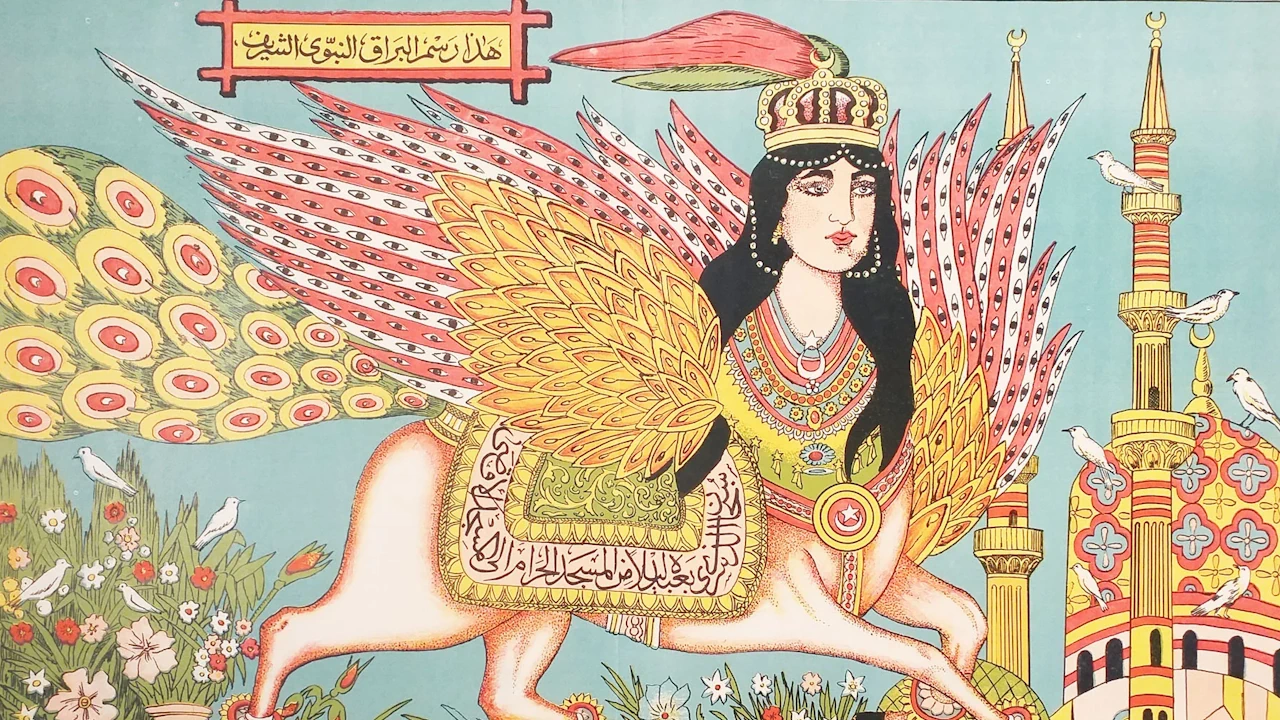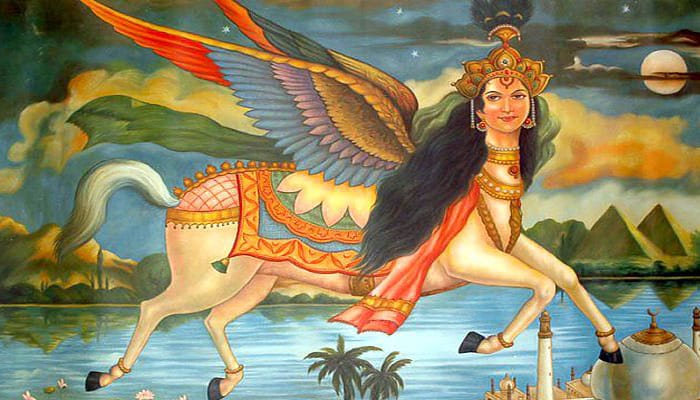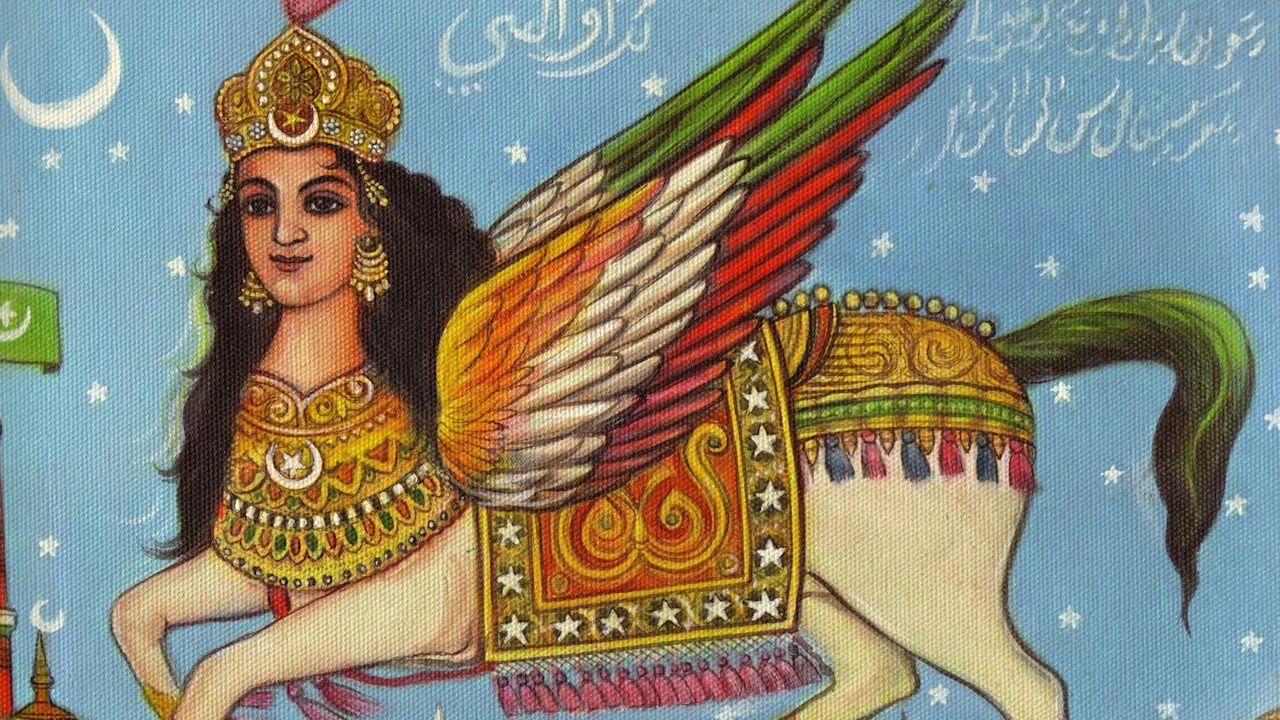We show you all the facts and legends about Buraq, the Islamic mythological creature with the body of a horse and the face of a woman.

Buraq
Buraq, in Islamic tradition, is a creature said to have transported the prophet Muhammad to heaven. Described as “a white animal, half mule, half donkey, with wings on its sides. Buraq was originally introduced into the story of Muhammad’s night journey from Mecca to Jerusalem and back, explaining how the journey between the cities could have been completed in a single night.
In some traditions, it became a steed with the head of a woman and the tail of a peacock. When the night journey story was connected with that of Muhammad’s ascension to heaven, Buraq replaced the ladder as Muhammad’s means of access to heaven.
Since at least the 14th century, the myth of Buraq, visualized on the basis of ancient representations of griffins, sphinxes, and centaurs, became a favorite subject of Persian miniature painting.
1. Meanings
The name Buraq has the following meanings: “shining, resplendent, brilliant, bright, radiant, glowing, dazzling, resplendent, shining, shining, resplendent, resplendent, resplendent, resplendent, resplendent, resplendent.”

It is a creature in Islamic tradition that resembles the mythological hybrids of the Near East (particularly the protective deities of Mesopotamia), which was said to be a means of transportation for certain prophets.
Most notable are the hadith accounts of the Isra and Mi’raj stories that the Buraq carried the Islamic prophet Muhammad from Mecca to Jerusalem and back to the heavens overnight.
2. Etymology
The Encyclopedia of Islam, referring to the writings of Al-Damiri, considers the Buraq to be a derivative and adjective of the Arabic: barq “lightning/emitted lightning” or various general meanings derived from the verb: “to beam, flash, gleam, glimmer, glisten, glitter, radiate, shimmer, shine, sparkle, twinkle.”
According to the Encyclopaedia Iranica, “Boraq” is the Arabized form of “Middle Persian barag or barag, ‘a riding beast, mount.'”
1. Origins of the mythical creature Buraq
The mythological creature called Buraq or Al-Buraq is found mainly in Islamic mythology and is mentioned in the Quran. There are many variations of the name, Al-Buraq, depending on the dialect and pronunciation and the region in which the story is told. In general, the form Al-Buraq is considered the generic version and will be used.
The Al-Buraq is a mythical creature of transportation. It is described as white in color and between the size of a donkey and a mule. It has the face of a woman and the wings of an eagle, as well as the tail of a peacock. The symbolism of the horse’s body and eagle’s wings implies rapid movement and the ability to carry a passenger.
The movement of one step is said to be equivalent to the distance of the creature’s vision. So not only can it carry a passenger on its equine body, but it can also move quickly due to the large wings on the sides of its body. This intensely fast movement could also be attributed to the name.
In Arabic, the word for Al-Buraq is al-buraaq, which in English means lightning (buraq).
Asmodeus: Demon King of the Nine Hells. Lust Incarnate2. Myth
The myth of Al-Buraq actually begins with the prophet Abraham. It is said that Al-Buraq took Abraham every morning to his wife, Hagar, in Mecca. At night, Al-Buraq would take Abraham back to Syria and his wife Sarah (buraq).
However, the true myth of Al-Buraq is a story told in the chapter of the Quran called “Night Journey.” The story says that in the 7th century, the prophet Muhammad told the story of the Night I Traveled with the Archangel Gabriel. He had been in Mecca visiting a cousin and had gone to the local mosque to pray and rest.
While there, the angel Gabriel came to him, followed by Al-Buraq. He was told to climb onto Al-Buraq, and then Muhammad and Gabriel traveled to the mosque that was said to be the farthest mosque from Mecca. In many stories, this location is assumed to be the Al-Aqsa Mosque in Jerusalem.
After Muhammad had worshipped in the mosque, Gabriel and Muhammad, riding on the Al-Buraq, traveled to various Heavens and Hells, or the second part of the journey, mi’raj. In the heavens, Muhammad was able to speak with other prophets, such as Abraham, Jesus, and Moses. He was then presented to Allah and asked to instruct the people to give him five prayers daily. Muhammad promised to tell the people and was returned to Mecca from where he started.
There is some controversy surrounding this myth as to whether the journey lasted one night, one second in human time, or if it was just a dream. There is no way to verify this, so believers continue to believe that it was a journey through time, while non-believers continue to say that it was just a dream.
3. Description
Although the Hadith do not explicitly refer to the Buraq as having a human face, Middle Eastern and Persian art almost always depict it as such—a representation that found its way into Indian and Persian Islamic art. This may have originated from an interpretation of the creature described as having a “beautiful face” as a human face rather than a beastly one.
Excerpt describing the Buraq
At that moment, they sent me a white beast that was a little smaller than a mule and a little taller than a donkey. The beast’s stride (was so wide that it reached the furthest point of the animal’s sight.
Another description of the Buraq
At that moment, Gabriel sent the Buraq, handsome of face and bound, a tall, white animal, taller than a donkey but smaller than a mule. It could place its hooves at the furthest point of its field of vision. It had long ears. Whenever it faced a mountain, its hind legs extended, and whenever it descended, its front legs extended. It had two wings on its legs that gave power to its thighs.
Celtic Zodiac of the Animals. Meet his 13 Mistical Signs
He resisted when Muhammad came to ride him. The angel Gabriel placed his hand on its mane and said, “Are you not ashamed, O Buraq? By Allah, no one has ridden you in the entire firmament more desired by Allah than he.” Upon hearing this, it blushed so much that it sweated until it was like soup, and it held back until the Chosen One rode it.
In the above descriptions, there is no agreement as to the sex of the Buraq. The image of the beast “al Buraq” as purely a heavenly mare is also alluded to in a famous book called “The Dome of the Rock,” where the chapter mentions it as “The Open Court,” and in Georg Ebers’ illustration of the episode entitled Palestine.
4. Journey to the Seventh Heaven
According to Islamic custom, the Night Journey took place 10 years after Muhammad became a prophet, in the mid-7th century. Muhammad had been in Mecca, at the house of his cousin (the house of Fakhitah bint Abi Talib), when he went to al-Masjid al-Haram (Al-Haram Mosque).
While resting at the Kaaba, Gabriel appeared to him bringing the Buraq, which carried Muhammad in the company of the archangel to al-Masjid al-Aqsa, traditionally considered the Temple Mount in Jerusalem.
At this place, he dismounted from the Buraq, prayed at the site of the Holy Temple (Bayt Al-Maqdis), and then mounted it again as the creature ascended to the seven heavens where he met Adam, Jesus, and his cousin John the Baptist, Joseph, Enoch, Aaron, Moses, and Abraham one by one until he reached the throne of God.
God communicated with him, giving him words and instructions, most notably the commandment to Muslims to offer prayers, initially fifty times a day. At Moses’ request, Muhammad returned to God several times before reducing the number to five.
5. Abraham
According to Ibn Ishaq, the Buraq transported Abraham when he visited Hagar and Ishmael. Custom has it that Abraham used to live with his wife Sarah in Palestine, but the Buraq beasts would take him to Mecca in the early morning to visit his family there and transport him back at night.
Spanish Symbology: 10 Signs, Origins and Myths6. Western Wall
The mosque sits on an ancient passageway that once led out through Barclay’s Gate, whose huge lintel remains visible beneath the Maghrebian gate. Due to its proximity to the Western Wall, the area surrounding the wall has been associated with Buraq since at least the 19th century.
When a British Jew asked the Egyptian authorities in 1840 for permission to repave the ground in front of the Western Wall, the governor of Syria wrote:
From the copy of the minutes of the deliberations of the Jerusalem Advisory Council, it appears that the place where the Jews requested permission to pave is adjacent to the wall of the Haram al-Sharif and also to the place where the Buraq was moored, and is included in the letter of endowment of Abu Madyan, may God bless his memory; that the Jews have never made repairs to that place in the past.
For Muslims, the Western Wall (formerly the Western Wall) is known as “al-Ḥa iá¹u l-Buraq” “the Wailing Wall.”
Since on the other side (the Muslim side of the Wailing Wall on the Temple Mount) is where Muhammad tied the Buraq, the riding animal he rode during the Night of Ascension. The wall joins the structure of the Al-Buraq Mosque.
The Buraq is identical to and associated with other mythical creatures such as the Filipino Sarimanok, the Persian Simurgh, and the Hindu and Buddhist Garuda.

